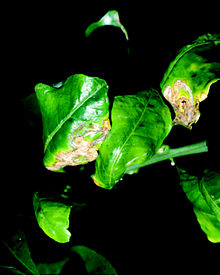Citrus canker
| Xanthomonas axonopodis | |
|---|---|
| Scientific classification | |
| Kingdom: | Bacteria |
| Phylum: | Proteobacteria |
| Class: | Gammaproteobacteria |
| Order: | Xanthomonadales |
| Family: | Xanthomonadaceae |
| Genus: | Xanthomonas |
| Species: | X. axonopodis |
| Binomial name | |
|
Xanthomonas axonopodis (Hasse, 1915) |
|
| Synonyms | |
|
Pseudomonas citrii |
|
Citrus canker is a disease affecting Citrus species caused by the bacterium Xanthomonas axonopodis. Infection causes lesions on the leaves, stems, and fruit of citrus trees, including lime, oranges, and grapefruit. While not harmful to humans, canker significantly affects the vitality of citrus trees, causing leaves and fruit to drop prematurely; a fruit infected with canker is safe to eat, but too unsightly to be sold.
The disease, which is believed to have originated in Southeast Asia, is extremely persistent when it becomes established in an area. Citrus groves have been destroyed in attempts to eradicate the disease. Brazil and the United States are currently suffering from canker outbreaks.
Pseudomonas citrii
Xanthomonas campestris pv. citri
Xanthomonas citri
Xanthomonas axonopodis is a rod-shaped Gram-negative bacterium with polar flagella. The bacterium has a genome length around 5 megabase pairs. A number of types of citrus canker diseases are caused by different pathovars and variants of the bacterium:
Plants infected with citrus canker have characteristic lesions on leaves, stems, and fruit with raised, brown, water-soaked margins, usually with a yellow halo or ring effect around the lesion. Older lesions have a corky appearance, still in many cases retaining the halo effect. The bacterium propagates in lesions in leaves, stems, and fruit. The lesions ooze bacterial cells that, when dispersed by windblown rain, can spread to other plants in the area. Infection may spread further by hurricanes. The disease can also be spread by contaminated equipment, and by transport of infected or apparently healthy plants. Due to latency of the disease, a plant may appear to be healthy, but actually be infected.
Citrus canker bacteria can enter through a plant's stomata or through wounds on leaves or other green parts. In most cases, younger leaves are considered to be the most susceptible. Also, damage caused by citrus leaf miner larvae (Phyllocnistis citrella) can be sites for infection to occur. Within a controlled laboratory setting, symptoms can appear in 14 days following inoculation into a susceptible host. In the field environment, the time for symptoms to appear and be clearly discernible from other foliar diseases varies; it may be on the order of several months after infection. Lower temperatures increase the latency of the disease. Citrus canker bacteria can stay viable in old lesions and other plant surfaces for several months.
...
Wikipedia

